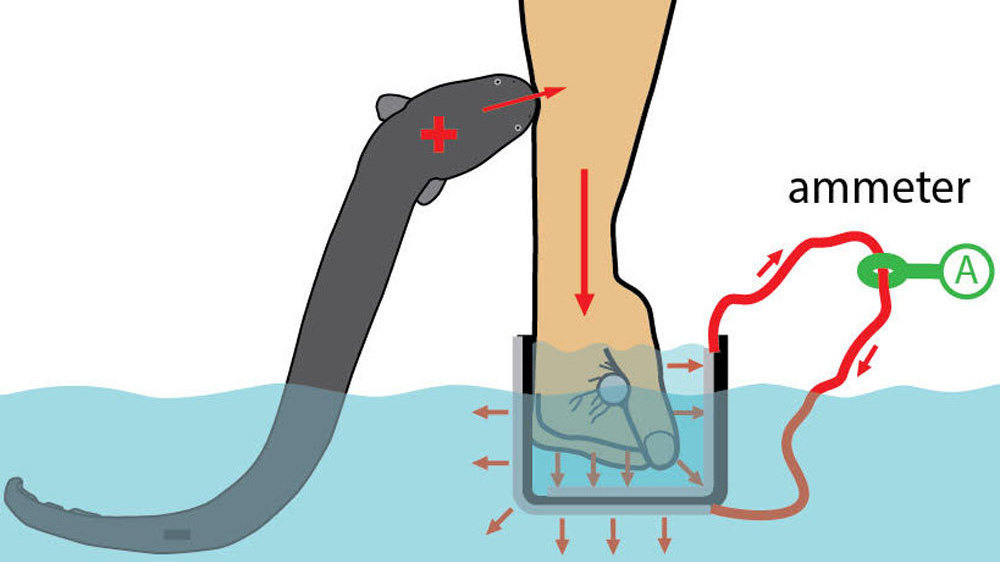What a deadly electric eel!!!!
The electric eel has an elongated, cylindrical body, typically growing to about 2 m (6 ft 7 in) in length, and 20 kg (44 lb) in weight, making them the largest species of the Gymnotiformes. Their coloration is dark gray-brown on the back and yellow or orange on the belly. Mature females have a darker color on the belly. They have no scales. The mouth is square, and positioned at the end of the snout. The anal fin extends the length of the body to the tip of the tail.
As in other ostariophysan fishes, the swim bladder has two chambers. The anterior chamber is connected to the inner ear by a series of small bones derived from neck vertebrae called the Weberian apparatus, which greatly enhances its hearing capability. The posterior chamber extends along the whole length of the body and maintains the fish's buoyancy. E. electricus has a well-developed sense of hearing. This fish has a vascularized respiratory system with gas exchange occurring through epithelial tissue in its buccal cavity. As obligate air-breathers, electric eels must rise to the surface every ten minutes or so to inhale before returning to the bottom. Nearly eighty percent of the oxygen used by the fish is obtained in this way.
Despite its name, the electric eel is not closely related to the true eels (Anguilliformes) but is a member of the neotropical knifefish order (Gymnotiformes), which is more closely related to the catfish.
The electric eel has three pairs of abdominal organs that produce electricity: the main organ, the Hunter's organ, and the Sach's organ. These organs make up four fifths of its body, and give the electric eel the ability to generate two types of electric organ discharges: low voltage and high voltage. These organs are made of electrolytes, lined up so a current of ions can flow through them and stacked so each one adds to a potential difference.
When the eel finds its prey, the brain sends a signal through the nervous system to the electrolytes. This opens the ion channels, allowing sodium to flow through, reversing the polarity momentarily. By causing a sudden difference in electric potential, it generates an electric current in a manner similar to a battery, in which stacked plates each produce an electric potential difference.
In the electric eel, some 5,000 to 6,000 stacked electro plaques can make a shock up to 860 volts and 1 ampere of current (860 watts) for two milliseconds (MS). Such a shock is extremely unlikely to be deadly for an adult human, due to the very short duration of the discharge. Atrial fibrillation requires that roughly 700 mA be delivered across the heart muscle for 30 MS or more, far longer than the eel can produce. Still, this level of current is reportedly enough to produce a brief and painful numbing shock likened to a stun gun discharge, which due to the voltage can be felt for some distance from the fish; this is a common risk for aquarium caretakers and biologists attempting to handle or examine electric eels.
The Such’s organ is associated with electro location. Inside the organ are many muscle-like cells, called electrolytes. Each cell can only produce 0.15 V, though the organ can transmit a signal of nearly 10 V overall in amplitude at around 25 Hz in frequency. These signals are emitted by the main organ; the Hunter's organ can emit signals at rates of several hundred hertz.
The electric eel is unique among the Gymnotiformes in having large electric organs that can produce potentially lethal discharges that allow them to stun prey. Larger voltages have been reported, but the typical output is sufficient to stun or deter virtually any animal. Juveniles produce smaller voltages (about 100 V). They can vary the intensity of the electric discharge, using lower discharges for hunting and higher intensities for stunning prey or defending themselves. They can also concentrate the discharge by curling up and making contact at two points along its body. When agitated, they can produce these intermittent electric shocks over at least an hour without tiring.
The electric eel also possesses high frequency–sensitive tuberous receptors, which are distributed in patches over its body. This feature is apparently useful for hunting other Gymnotiformes.
Researchers at Yale University and the National Institute of Standards and Technology argue artificial cells could be built that not only replicate the electrical behavior of electric eel cells, but also improve on them. Artificial versions of the eel's electricity-generating cells could be developed as a power source for medical implants and other microscopic devices.



WARNING - The message you received from @sitisahro is a CONFIRMED SCAM!
DO NOT FOLLOW any instruction and DO NOT CLICK on any link in the comment!
For more information, read this post: https://steemit.com/steemit/@arcange/phishing-site-reported-steemitservices-dot-ml
Please consider to upvote this warning if you find my work to protect you and the platform valuable. Your support is welcome!
Thank you for your kind information.
Hi! I am a robot. I just upvoted you! I found similar content that readers might be interested in:
https://en.wikipedia.org/wiki/Electric_eel
Exclusive 30 days free upvotes to your every new post. No need to send any kinds of steem or sbd its full free service. we have paid service too so please check them too. Active the free upvote service and learn more about it here : https://t.co/jjbChkFdwx